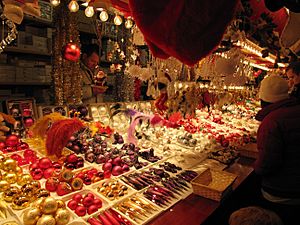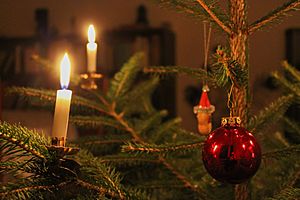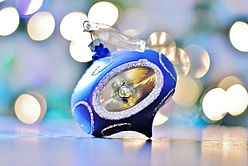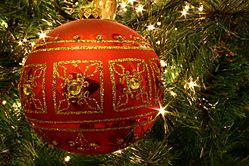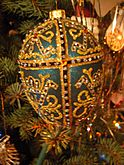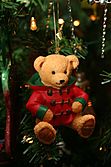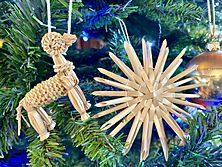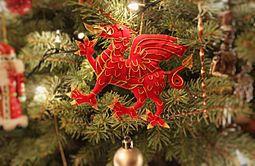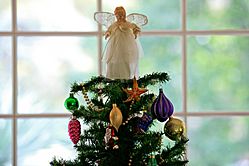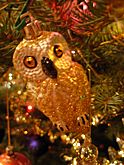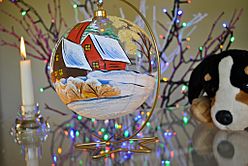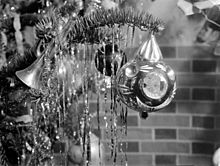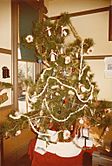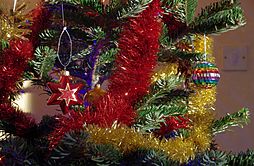Christmas ornament facts for kids
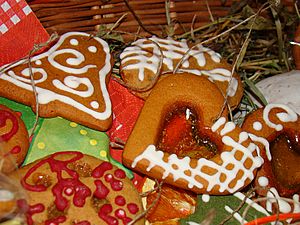
Christmas ornaments are special decorations, often called baubles or "Christmas bulbs." People usually hang them on Christmas trees. These decorations can be made in many ways, like by blowing glass, molding ceramic or metal, carving wood, or even weaving.
Ornaments come in all sorts of shapes and pictures. Families usually keep their ornaments and use them every year. Often, family collections include both store-bought ornaments and ones made by family members. These collections are often passed down through generations. People often choose ornaments shaped like festive figures or images.
In the 1870s, a story by Lucretia P. Hale called "The Peterkins' Christmas-Tree" described some of the ornaments used back then. It mentioned "every kind of gilt hanging-thing, from gilt pea-pods to butterflies on springs. There were shining flags and lanterns, and bird-cages, and nests with birds sitting on them, baskets of fruit, gilt apples, and bunches of grapes."
The modern colored glass Christmas ornament, made by blowing glass into a mold, was first created in the small German town of Lauscha in the mid-1500s.
Contents
History of Christmas Ornaments
How Were Christmas Ornaments Invented?
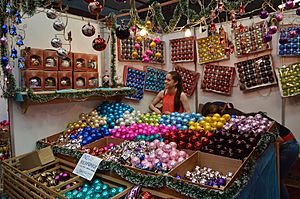
The very first decorated Christmas trees had simple things like apples, white candy canes, and pastries shaped like stars, hearts, and flowers.
The first Glass baubles were made in Lauscha, Germany, by Hans Greiner around 1550. He made long strings of glass beads and small tin figures to hang on trees. These decorations became very popular. Soon, skilled artisans started making glass figures using clay molds.
These artisans would heat a glass tube over a flame. Then, they would put the hot tube into a clay mold. By blowing into the tube, the heated glass would expand and take the shape of the mold. At first, the ornaments were only shaped like fruits and nuts.
After the glass cooled, a special liquid called silver nitrate was swirled inside. This made the ornament shiny and silver-like. This silvering method was developed in the 1850s by Justus von Liebig. Once the liquid dried, the ornament was hand-painted and finished with a cap and a hook for hanging.
How Did Christmas Ornaments Spread Around the World?
Other glassblowers in Lauscha saw how popular Christmas baubles were becoming. They began making them in many different designs. Soon, people all over Germany were buying Christmas glass decorations from Lauscha.
In 1832, a young Queen Victoria wrote about how happy she was to have a Christmas tree. It was decorated with lights, ornaments, and presents. In the 1840s, a picture of Queen Victoria's Christmas tree appeared in a London newspaper. It showed her tree decorated with glass ornaments and baubles from her husband Prince Albert's home country, Germany. After this, Lauscha started sending its products all over Europe.
In the 1880s, an American businessman named F. W. Woolworth visited Germany. He discovered Lauscha's beautiful baubles. He made a lot of money by bringing these German glass ornaments to the United States.
How Did Ornaments Become Mass-Produced?
The first American-made glass ornaments were created by William DeMuth in New York in 1870. By 1880, Woolworth's stores started selling Lauscha glass ornaments. Other stores also began selling Christmas ornaments in the late 1800s. By 1910, Woolworth's had grown to over 1,000 stores across America, bringing Christmas ornaments to many homes. New companies appeared, offering different types of ornaments, like Dresden die-cut fiberboard ornaments, which were popular with families who had small children.
By the 1900s, Woolworth's had imported 200,000 ornaments. They made over $25 million just from Christmas decorations. As of 2009, the Christmas decoration business was the second biggest seasonal sales industry, right after gifts.
Many silver companies, like Gorham and Wallace, also started making silver Christmas ornaments in the early 1970s.
In 1973, Hallmark Cards began making Christmas ornaments. Their first collection had 18 ornaments, including six glass balls. The Hallmark Keepsake Ornament collection is special because each ornament is dated and only sold for one year. By 1998, 11 million American families collected Hallmark ornaments. A quarter of a million people were members of the Keepsake Ornament Collector's Club. There were even 400 local clubs in the U.S.! A famous expert on Christmas ornaments is Clara Johnson Scroggins, who has written many books on the topic and has one of the largest private collections.
In 1996, the ornament industry made $2.4 billion in sales, which was a 25% increase from the year before. Experts believed that over 22 million U.S. homes collected Christmas ornaments, and 75% of those collected Hallmark Keepsake Ornaments.
What Happened After World War II?
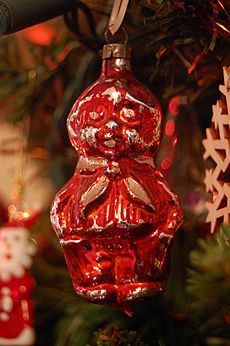
After World War II, the government in East Germany took control of most of Lauscha's glass factories. This stopped the production of baubles there for a while. When the Berlin Wall came down, most of these companies became private again. As of 2009, about 20 small glass-blowing companies in Lauscha still make baubles. One of them, Krebs Glas Lauscha, is now one of the biggest glass ornament makers in the world.
Modern Christmas Baubles
Even though glass baubles are still made and sold as expensive, good-quality ornaments, many baubles today are made from plastic. They are sold all over the world in a huge variety of shapes, colors, and designs.
Many companies in Poland make beautiful glass Christmas ornaments, called "bombka" (or "bombki" for plural). Millions of glass-blown Christmas ornaments are also made year-round in Tlalpujahua, Michoacan, Mexico. These are sent to countries like Spain, New Zealand, and France. Ornaments are also made in Chignahuapan, Puebla, Mexico.
Handcrafted Ornaments
Handmade Christmas ornaments are very popular at craft fairs. Many small online businesses have become successful because of the internet and the growth of craft stores. Foods like sugar cookies, popcorn balls, gingerbread, and many types of cookies can also be used as ornaments.
How Handmade Glass Ornaments Are Made
Types of Christmas Ornaments
- Christmas tree ornaments
-
Crochet ornaments
-
Christmas tree with tinsel garland.
-
Christmas tree with tinsel lametta (long narrow strips)
See Also
 In Spanish: Adorno navideño para niños
In Spanish: Adorno navideño para niños


